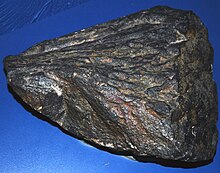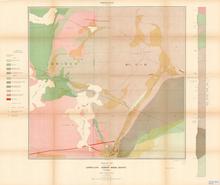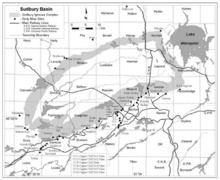Sudbury Basin
| Sudbury Basin | |
|---|---|
| Sudbury Structure | |
 NASA World Wind satellite image of the Sudbury astrobleme | |
| Impact crater/structure | |
| Confidence | Confirmed |
| Diameter | 130 km (81 mi) |
| Age | 1849 Ma Paleoproterozoic |
| Exposed | Yes |
| Drilled | Yes |
| Bolide type | Chondrite |
| Location | |
| Coordinates | 46°36′N 81°11′W / 46.600°N 81.183°W |
| Country | Canada |
| Province | Ontario |


The Sudbury Basin (/ˈsʌdbəri/), also known as Sudbury Structure or the Sudbury Nickel Irruptive, is a major geological structure in Ontario, Canada. It is the third-largest known impact structure on Earth, as well as one of the oldest.[1] The structure, the eroded remnant of an impact crater, was formed by the impact of an asteroid 1.849 billion years ago in the Paleoproterozoic era.[2]
The basin is located on the Canadian Shield in the city of Greater Sudbury, Ontario. The former municipalities of Rayside-Balfour, Valley East and Capreol lie within the Sudbury Basin, which is referred to locally as "The Valley". The urban core of the former city of Sudbury lies on the southern outskirts of the basin.
An Ontario Historical Plaque was erected by the province to commemorate the discovery of the Sudbury Basin.[3]
Formation
[edit]
The Sudbury basin formed as a result of an impact into the Nuna supercontinent from a large impactor body approximately 10–15 km (6.2–9.3 mi) in diameter that occurred 1.849 billion years ago[2] in the Paleoproterozoic era.
Debris from the impact was scattered over an area of 1,600,000 km2 (620,000 sq mi) thrown more than 800 km (500 mi); and ejecta—rock fragments ejected by the impact—have been found as far away as Minnesota.[4][5][6]
Models suggest that for such a large impact, debris was most likely scattered globally,[7] but has since been eroded. Its present size is believed to be a smaller portion of a 130 km (81 mi) round crater that the meteor originally created. Subsequent geological processes have deformed the crater into the current smaller oval shape. Sudbury Basin is the third-largest crater on Earth, after the 300 km (190 mi) Vredefort impact structure in South Africa, and the 180 km (110 mi) Chicxulub crater under Yucatán, Mexico.
Geochemical evidence suggests that the impactor was likely a chondrite asteroid or a comet with a chondritic component.[8]
Structure
[edit]The full extent of the Sudbury Basin is 62 km (39 mi) long, 30 km (19 mi) wide and 15 km (9.3 mi) deep although the modern ground surface is much shallower.[citation needed]
The main units characterizing the Sudbury Structure can be subdivided into three groups: the Sudbury Igneous Complex (SIC), the Whitewater Group, and footwall brecciated country rocks that include offset dikes and the Sub layer. The SIC is believed to be a stratified impact melt sheet composed from the base up of sub layer norite, mafic norite, felsic norite, quartz gabbro, and granophyre.[citation needed]
The Whitewater Group consists of a suevite and sedimentary package composed of the Onaping (fallback breccias), Onwatin, and Chelmsford Formations in stratigraphic succession. Footwall rocks, associated with the impact event, consist of Sudbury Breccia (pseudotachylite), footwall breccia, radial and concentric quartz dioritic breccia dikes (polymict impact melt breccias), and the discontinuous sub layer.[citation needed]
Because considerable erosion has occurred since the Sudbury event, an estimated 6 km (3.7 mi) in the North Range, it is difficult to directly constrain the actual size of the diameter of the original transient cavity, or the final rim diameter.[9]
The deformation of the Sudbury structure occurred in five main deformation events (by age in millions of years):
- formation of the Sudbury Igneous Complex (1849 Ma)[2]
- Penokean orogeny (1890–1830 Ma)
- Mazatzal orogeny (1700–1600 Ma)[10]
- Grenville orogeny (1400–1000 Ma)
- Lake Wanapitei impact (37 Ma)
Origin
[edit]
Some 1.8 billion years of weathering and deformation made it difficult to prove that a meteorite was the cause of the Sudbury geological structures. A further difficulty in proving that the Sudbury complex was formed by meteorite impact rather than by ordinary igneous processes was that the region was volcanically active at around the same time as the impact, and some weathered volcanic structures can look like meteorite collision structures. Since its discovery, a layer of breccia has been found associated with the impact event[11] and stressed rock formations have been fully mapped.
Reports published in the late 1960s described geological features that were said to be distinctive of meteorite impact, including shatter cones[12] and shock-deformed quartz crystals in the underlying rock.[13] Geologists reached consensus by about 1970 that the Sudbury basin was formed by a meteorite impact.[citation needed] In 2014, analysis of the concentration and distribution of siderophile elements as well as the size of the area where the impact melted the rock indicated that a comet rather than an asteroid most likely caused the crater.[14][15]

The Sudbury Basin is located near a number of other geological structures, including the Temagami Magnetic Anomaly, the Lake Wanapitei impact crater, the western end of the Ottawa-Bonnechere Graben, the Grenville Front Tectonic Zone and the eastern end of the Great Lakes Tectonic Zone, but the structures are not directly related to one another in the sense of resulting from the same geological processes.[citation needed]
Mining
[edit]
The large impact crater filled with magma containing nickel, copper, palladium, gold, the platinum group and other metals.[16] This magma formed into pyrrhotite, chalcopyrite and pentlandite rocks,[17][18] as well as cubanite and magnetite.[19]
In 1856 while surveying a baseline westward from Lake Nipissing, provincial land surveyor Albert Salter located magnetic abnormalities in the area that were strongly suggestive of mineral deposits, especially near what later became the Creighton Mine.[20] The area was examined by Alexander Murray of the Geological Survey of Canada,[20] who confirmed "the presence of an immense mass of magnetic trap".[21]
Due to the then-remoteness of the Sudbury area, Salter's discovery did not have much immediate effect. The construction of the Canadian Pacific Railway through the area, however, made mineral exploration more feasible. The development of a mining settlement occurred in 1883 after blasting at the railway construction site revealed a large concentration of nickel and copper ore at what is now the Murray Mine site, named by owners William and Thomas Murray.[20]
The Vermillion Mine, which was the first in the Basin to be exploited, was the site at which Frank Sperry (a chemist of the Canadian Copper Company) made the first identification in 1889 of the arsenide of platinum which bears his name.[22]
As a result of the 1917 Royal Ontario Nickel Commission, which was chaired by Englishman George Thomas Holloway, the legislative structure of the prospecting trade was significantly altered.[23] Some of the Holloway recommendations were in line with the advocacy of Aeneas McCharles, a 19th-century prospector and early mine owner.[24]
As a result of these metal deposits, the Sudbury area is one of the world's major mining communities, and has fathered Vale Inco and Falconbridge Xstrata. The Basin is one of the world's largest suppliers of nickel and copper ores. Most of these mineral deposits are found on its outer rim.[citation needed]
Soils
[edit]Most soils in the Sudbury Basin are acidic and sandy; where well drained they usually belong to the Podzol great soil group. Poor drainage results in gleysols and peats. Regardless of drainage or classification, the Basin has deeper soils than the surrounding terrain, much of which is mapped as Rockland (a combination of frequent bedrock outcrops and shallow soil). Consequently, considerable areas in the Basin have been cleared for agriculture. The best soils, mapped as Azilda series and Bradley series, occur around Chelmsford.[25]
Astronaut training
[edit]NASA used the site to train the Apollo astronauts in recognizing rocks formed as the result of a very large impact, such as breccias. Those who used this training on the Moon include Apollo 15's David Scott and James Irwin, Apollo 16's John Young and Charlie Duke, and Apollo 17's Gene Cernan and Jack Schmitt. Notable geologist instructors included William R. Muehlberger.[26]
See also
[edit]- Economic geology
- Geology of Ontario
- List of impact craters on Earth
- List of possible impact structures on Earth
References
[edit]- ^ "Sudbury". Earth Impact Database. Planetary and Space Science Centre University of New Brunswick Fredericton. Retrieved 2017-10-09.
- ^ a b c Davis, Donald W. (January 23, 2008). "Sub-million-year age resolution of Precambrian igneous events by thermal extraction-thermal ionization mass spectrometer Pb dating of zircon: Application to crystallization of the Sudbury impact melt sheet". Geology. 36 (5): 383–386. Bibcode:2008Geo....36..383D. doi:10.1130/G24502A.1.
- ^ Brown, Alan L. "Discovery of the Sudbury Nickel Deposits". Ontario's Historical Plaques. Retrieved 2018-05-12.
- ^ Jirsa, M.A. (2008) and Retzler, A.J. (2020) "Ancient Meteorite Deposit in Minnesota", Minnesota Geological Survey
- ^ Associated Press: "Ontario crater debris found in Minn.", Star Tribune, July 15, 2007
- ^ "Ancient Meteorite Debris Found In Minn". CBS News. Associated Press. July 16, 2007.
- ^ Melosh, H.J. (1989). Impact Cratering: A Geologic Process. Oxford monographs on geology and geophysics: Issue 11. Oxford University Press. ISBN 978-0-1950-4284-9.
- ^ Petrus, Joseph A.; Ames, Doreen E.; Kamber, Balz S. (February 2015). "On the track of the elusive Sudbury impact: geochemical evidence for a chondrite or comet bolide". Terra Nova. 27 (1): 9–20. Bibcode:2015TeNov..27....9P. doi:10.1111/ter.12125. S2CID 129480630.
- ^ Pye, E.G.; Naldrett, A.J.; Giblin, P.E. (1984). The Geology and Ore Deposits of the Sudbury Structure. Ontario Geological Survey. Vol. 1. Ontario Ministry of Natural Resources.[permanent dead link]
- ^ Riller, U (2005). "Structural characteristics of the Sudbury impact structure, Canada: Impact-induced versus orogenic deformation-A review". Meteoritics & Planetary Science. 40 (11): 1723–1740. doi:10.1111/j.1945-5100.2005.tb00140.x.
- ^ Beales, FW; Lozej, GP (1975). "Sudbury Basin Sediments and the Meteoritic Impact Theory of Origin for the Sudbury Structure". Canadian Journal of Earth Sciences. 12 (4): 629–635. Bibcode:1975CaJES..12..629B. doi:10.1139/e75-056.
- ^ Bray, JG (1966). "Shatter Cones at Sudbury". The Journal of Geology. 74 (2): 243–245. Bibcode:1966JG.....74..243B. doi:10.1086/627158. S2CID 128465927.
- ^ French, BM (1967). "Sudbury Structure, Ontario: Some Petrographic Evidence for Origin by Meteorite Impact". Science. 156 (3778): 1094–1098. Bibcode:1967Sci...156.1094F. doi:10.1126/science.156.3778.1094. hdl:2027/pst.000020681982. PMID 17774054. S2CID 21607637.
- ^ Petrus, JA; Ames, DE; Kamber, BS (2015). "On the track of the elusive Sudbury impact: geochemical evidence for a chondrite or comet bolide". Terra Nova. 27 (1): 9–20. Bibcode:2015TeNov..27....9P. doi:10.1111/ter.12125.
- ^ Ghose, Tia (November 18, 2014). "A Comet Did It! Mystery of Giant Crater Solved". LiveScience. Retrieved November 18, 2014.
- ^ Molnár, Ferenc; Watkinson, David H.; Everest, John O. (1999). "Fluid-inclusion characteristics of hydrothermal Cu–Ni–PGE veins in granitic and metavolcanic rocks at the contact of the Little Stobie deposit, Sudbury, Canada". Chemical Geology. 154 (1–4): 279–301. Bibcode:1999ChGeo.154..279M. doi:10.1016/S0009-2541(98)00136-3.
- ^ Magyarosi, Zsuzsanna; Watkinson, David H.; Jones, Peter C. (2002). "Mineralogy of Cu-Ni-PGE ore and Sequence of Events in the Copper Cliff South Mine, Sudbury, Ontario" (PDF). 9th International Platinum Symposium.
- ^ Bell, Robert (January 1891). The Nickel and Copper Deposits of Sudbury District, Canada. Geological Society of America Bulletin. pp. 125–140.
- ^ Harrison, P.A. (January 1983). ECONOMIC GEOLOGY OF SULPHIDE NICKEL DEPOSITS (PDF). Grahamstown: Rhodes University.
- ^ a b c Jewiss, Tom (Spring 1983). "The mining history of the Sudbury area". Rocks and Minerals in Canada.
- ^ "OHP - "SALTER'S MERIDIAN 1856" - Ontario Provincial Plaques on Waymarking.com". Waymarking.com. Retrieved 3 April 2021.
- ^ "Sperrylite". mindat.org and The Hudson Institute of Mineralogy. Retrieved 3 April 2021.
- ^ "GEORGE THOMAS HOLLOWAY". Trans IMM. 27. Northern Mine Research Society: 399–400. 1917–1918. Retrieved 3 April 2021.
- ^ Bemocked of Destiny : The Actual Struggles and Experiences of a Canadian Pioneer, and the Recollections of a Lifetime / By Aeneas McCharles. Toronto : William Briggs, 1908
- ^ "Soil Survey Report No. 49, Map Sudbury, Sheet 41l". Soils of Sudbury Area, Ontario.
- ^ Phinney, William (2015). Science Training History of the Apollo Astronauts. NASA SP -2015-626. pp. 247, 252.
External links
[edit]- Earth Impact Database
- Fallbrook Gem and Mineral Society – Sudbury Structure page
- Morgan, JW; Walker, RJ; Horan, MF; Beary, ES; Naldrett, AJ (January 2002). "190Pt– 186Os and 187Re– 187Os systematics of the Sudbury Igneous Complex, Ontario" (PDF). Geochimica et Cosmochimica Acta. 66 (2): 273–290. Bibcode:2002GeCoA..66..273M. doi:10.1016/S0016-7037(01)00768-2. Archived from the original (PDF) on 2006-09-30.
- Aerial Exploration of the Sudbury Impact Structure
- Sudbury Impact Structure at NASA Earth Observatory, September 20, 2021



